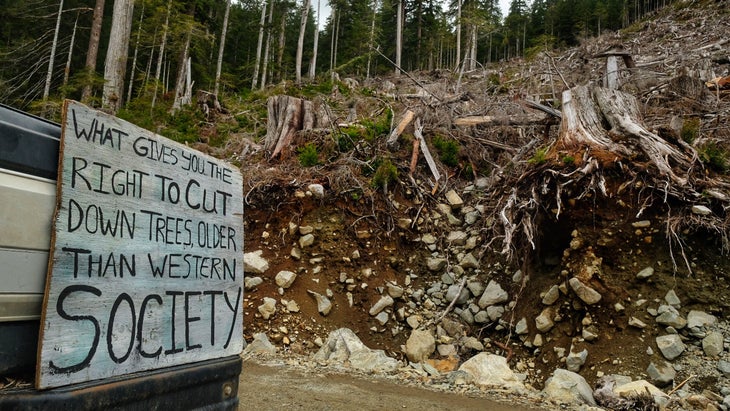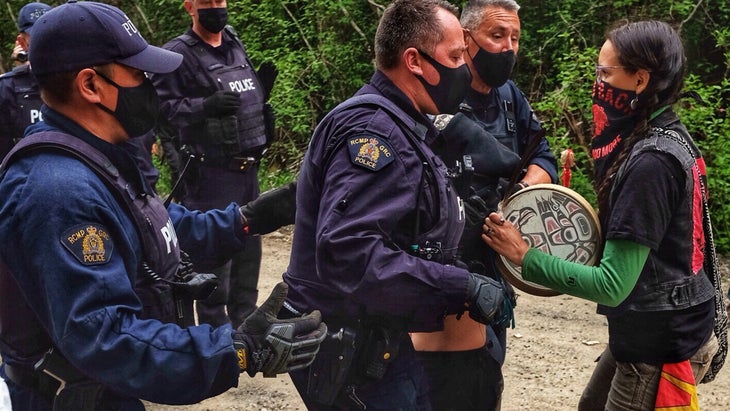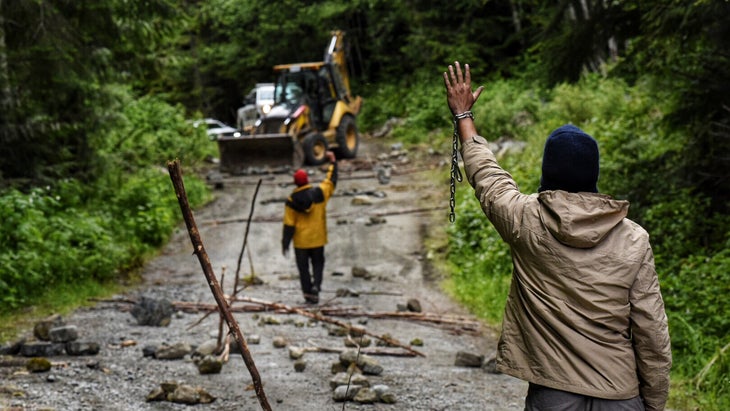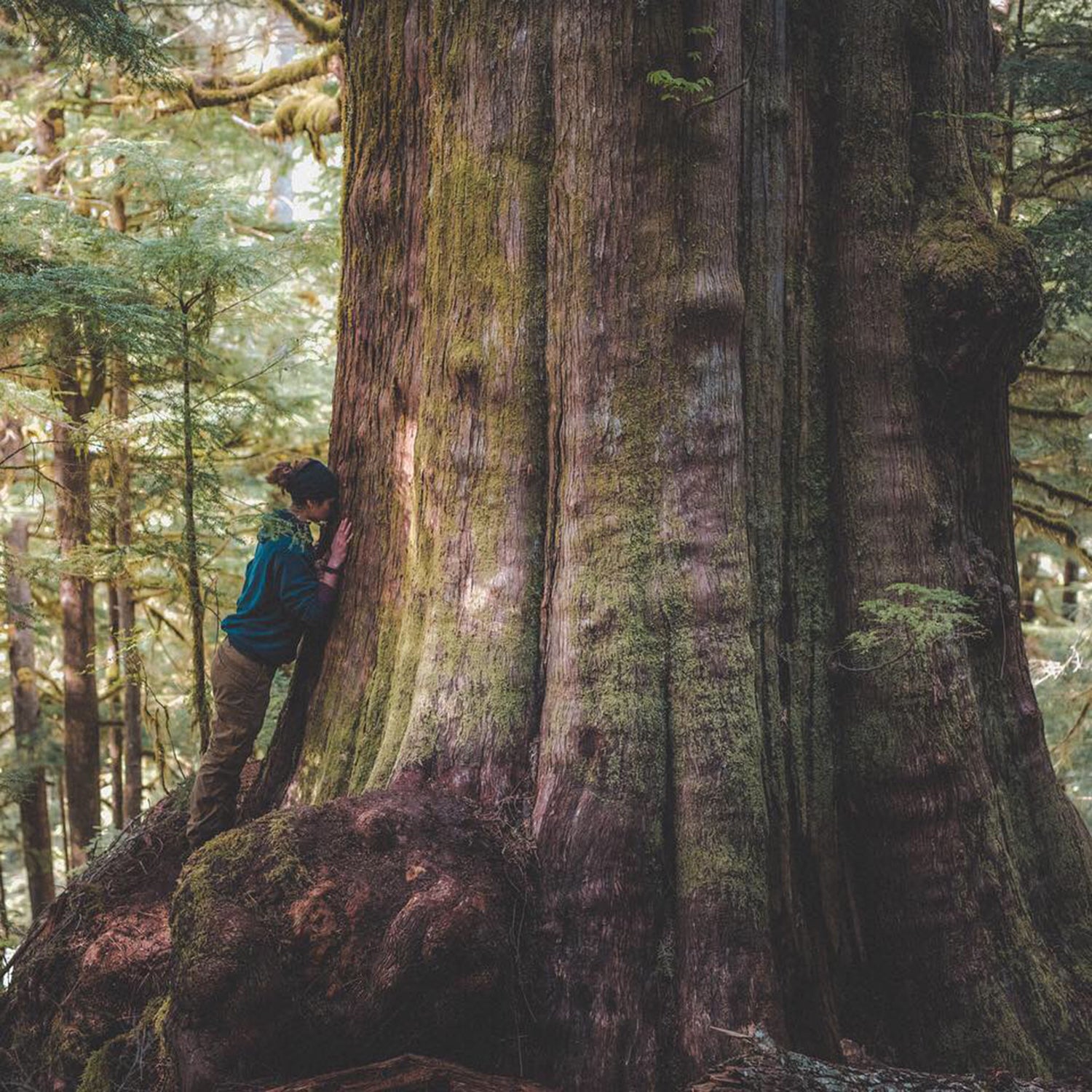The image on the photographer’s camera could be a scene from a dystopian film. In the muted light of dawn, an environmental activist sits chained to a tractor with a bicycle lock around his neck. A hand-painted banner strung across the machine reads “Stop Killing Old Growth.” Several indigenous women, also activists, stand in front of the machine, beating drums. Off to one side, a logger in an orange work shirt holds a fire hose, soaking the group with water.
It’s June 25, 2021, and I’m sharing a small patch of shade with —who goes by IBM, for Independent Black Media—under the makeshift media tent at Fairy Creek Headquarters, an encampment of activists in the remote southwest corner of British Columbia’s Vancouver Island. They have been blocking logging roads to prevent loggers from felling trees in this small swath of old-growth coastal temperate rainforest for just over a year now.
The 80 or so people at Fairy Creek Headquarters come from all over Canada—some to volunteer for a day or weekend, others, like IBM, are here indefinitely, having put their lives on hold to protect ancient trees. Collectively, they’re known as the Rainforest Flying Squad, in reference to the original protestors’ ability to quickly “fly” into the backcountry to set up blockades on logging roads. Currently, the Rainforest Flying Squad is maintaining nearly a dozen blockades which are guarded by volunteers 24 hours a day.

It’s the fiercest opposition to logging in British Columbia since 1993, when activists blocked fellers from clearcutting Clayoquot Sound, also on Vancouver Island, in a five-month standoff known as the War in the Woods—the largest act of civil disobedience in Canadian history, with close to 900 arrests. To date, 810 Fairy Creek protestors have been arrested. Most of the protestors in IBM’s photos were arrested the day we met—18 total, mostly women known as the Matriarchs. The youngest was Little Sage, age 18. The oldest was Cookie, age 73. (Everyone uses an alias here at Fairy Creek, for privacy reasons, and I agreed not to use their real names.)
Since its inception, the movement has grown far beyond a handful of nimble activists in the bush: the Rainforest Flying Squad’s private Facebook group has more than 9,000 members; its Instagram account has around 80,000 followers; now shuttle forest defenders, as activists have begun referring to themselves, back and forth to Fairy Creek on day trips from the capital city of Victoria. The weekend of June 18, 2021, when British Columbia lifted COVID-19 travel restrictions within the province, an estimated 2,000 people showed up at Fairy Creek Headquarters.
British Columbia, a landmass larger than California, Oregon, and Washington combined, used to be almost entirely covered in trees. Today, the province is home to 5.1 million people and just 23 percent—or 51,000 square miles—of its remaining forests are considered old growth (trees older than 250 years on the coast, and 140 years in the interior.) But that number is misleading: it includes high-elevation environments that don’t support the gigantic trees people think of when they hear “old growth.” Only is high-productivity old growth: those massive trees that act as carbon sinks, biodiversity wellsprings, and climate-change buffers. “These ecosystems are effectively the white rhino of old-growth forests,” reads an April 2020 on the state of BC forests. “They are almost extinguished and will not recover from logging.”
Many Canadians think that high productivity old-growth logging has already been banned, thanks to released by an independent panel of foresters over a year ago at the request of the BC government. The panel deemed current practices unsustainable, and made 14 recommendations, including an immediate moratorium on logging—or any form of development, like road-building—in old-growth forests. Many BC residents saw this news and trusted that those changes had been made. But the government has yet to actually implement any of the recommendations. Instead, in the last year, the BC government in areas containing old growth than in previous years.
Fairy Creek is an old-growth forest covering an area of about 5,140 acres. It’s believed to be the last unprotected old-growth watershed on southern Vancouver Island that hasn’t been touched by logging. There are no roads leading into this steep river valley surrounded by densely-forested mountains. Bears and cougars roam the stands of lichen-draped yellow cedars, some of which measure nearly ten feet in diameter. When seen from the aerial photos used by logging companies—who know this region as Tree Farm License 46—Fairy Creek appears as a continuous strip of dark green velvet surrounded by the tan-colored scabs of clear cuts.

The , the largest privately-operated forestry organization in the region, owns the permit to log within Tree Farm License 46, an area of about 206,000 acres. In 2020, Teal-Jones was logging in another old-growth forest in Tree Farm License 46 known as Caycuse. Local environmentalists, who’d been trying for years to preserve ancient trees using tactics like building trails through stands of old-growth to increase awareness, began discussing using blockades as a last resort, according to Crusty, 30, one of the Rainforest Flying Squad’s co-founders. But there was hesitation. “There was a lot of fear around it,” he says. They would be out in the backcountry, without cell phone service or any way to protect themselves from potentially angry loggers or police aggression.
They were spurred to action when a 17-year-old climate activist from Washington named Joshua Wright got in touch to tell them that, using satellite maps, he had discovered what appeared to be a logging road being built to access Fairy Creek. Shortly after, on August 9, 2020, Crusty and his colleagues found the road-in-progress and set up the first blockade, now known as Ridge Camp. They also stationed themselves on the existing logging roads leading to Caycuse, to try and save some of the old growth there.
To get around the protestors, Teal-Jones first needed to obtain a civil injunction from the court, which didn’t happen until April 1, 2021. It gave the Rainforest Flying Squad time to build their numbers—and their courage—and to block even more logging roads in Tree Farm License 46. By the time the local news began picking up the story, the forest defenders had spread beyond where they’d started at Fairy Creek.
The Royal Canadian Mounted Police (RCMP) began enforcing the injunction on May 17, arresting protest0rs who refuse to voluntarily leave the blockades. Many, like the man who used the bicycle lock to chain himself to the tractor, use creative techniques to make it as difficult and time-consuming as possible for police to extract them. This includes building “hard blockades,” contraptions that contain activists in precarious positions like sitting atop a 20-foot tall-wooden tripod, or laying across the road with an arm locked into the bottom of a concrete-filled hole.
Those blockades are the most critical component of the Rainforest Flying Squad’s three-part strategy, which they call the . They also advocate for policy changes. And they use social media to educate the general public about what’s at stake and to draw more volunteers to the protests.
The gate to the Rainforest Flying Squad encampment known as River is hand-built and covered in painted signs. “We want your children to know these forests too,” reads the largest. Inside, a group of four forest defenders have dug a hole in the middle of the logging road. They’re filling it with rebar, pieces of rubber tire, and concrete—a prototype, they tell me, for a new type of hard blockade. Beyond stands a well-constructed open-air kitchen made of lumber and corrugated iron, and deeper in, a canvas teepee that holds a small fire carefully ringed in stones.
There, I meet Sage, 23, who is of the Nuu-chah-nulth and Heiltsuk First Nations. She explains that the fire is ceremonial, and is kept continuously burning to “help keep the people strong.”
Sage is here nursing a sprained rib from her time on the front line last week, when an officer knelt on her back while extracting her from a hard blockade. Front line forest defenders periodically retreat to River to rest, she tells me. River is the most heavily fortified camp—visitors must first pass through one of the other camps and countless soft blocks (those that don’t contain activists’ bodies, like boulders and logs) to reach it. Granite Creek gushes through one end of the site, with waterfalls for jumping and tranquil pools for bathing. Unlike Fairy Creek Headquarters, there’s not a single clear cut in sight. Stands of ancient trees, including two mammoth cedars that have been dubbed Grandmother and Grandfather, line the rugged road.
River Camp is also the home of “Landback,” an indigenous youth program that Sage helps run to introduce local First Nations teens to the movement, as well as to help them reconnect with their land and culture. And to each other. “Most of us are only first, second, third generation out of ,” she tells me.
Fairy Creek, along with most of Tree Farm License 46, is located on the unceded lands of the Pacheedaht First Nation, which means the movement to protect these lands inherently intersects with issues of indigenous rights and sovereignty. First Nations have been fighting to protect old-growth forests for decades, and while the long-term goals of the protestors may align with theirs, some indigenous leaders advocate for a different approach. Certain Pacheedaht elders, like Bill Jones, 81, welcome the Rainforest Flying Squad on Pacheedaht lands, and have become an integral part of the protest movement. Others, like Jeff Jones, the elected chief of the Pacheedaht’s Band Council—the entity created from the 1876 Indian Act to replace First Nations’ traditional governing systems—have asked forest defenders to and let the Pacheedaht deal with the old-growth logging their way.

In June, the Pacheedaht Band Council, along with the Ditidaht’s and the Huu-ay-aht’s, called on the BC Government to defer all old-growth logging in Ada’itsx, the Fairy Creek Watershed, and in another nearby area known as Central Walbran, for two years so they could prepare resource management plans. The BC Government granted the First Nation’s request almost immediately, on June 9. But the Rainforest Flying Squad did not change course. That’s because the RCMP, the loggers, and their equipment are still there, including on the new logging road that would have crested the ridge into Fairy Creek had a small group of activists not enacted the first blockade there ten months prior. Nor does the deferral protect any of the other old-growth forests—like Caycuse—in Tree Farm License 46. Or the rest of the 2.7-percent of remaining high-productivity old growth across BC.
“This announcement does nothing to address the systemic crisis in the way our forests are managed,” reads a press release issued by the Rainforest Flying Squad after the deferral was granted. “Until these things happen, at the invitation of Elder Bill Jones, the Rainforest Flying Squad will continue to stand our ground to defend our last ancient forests.”
For the Rainforest Flying Squad, deferring logging and buying time for a yet-to-be-determined end goal is not enough. Forest defenders want the BC government to enact the 14 recommendations of the independent panel—most importantly the immediate moratorium on old-growth logging.
Not everyone who arrives at one of Fairy Creek’s encampments is aware that they are stepping into something greater than an environmental movement. One clue: along the bumpy logging road between Headquarters and River, hundreds of red dresses hang on wooden stakes in an otherwise barren clear-cut mountainside. It’s a memorial created by forest defenders to honor missing and murdered indigenous women, girls, and two-spirit people. “There’s certain people coming in who are like, ‘Oh I’m here for the trees,’” Sage says. “And I’m like, you’re also here for the people.”
Grandfather Cedar is ten feet wide, and stands just off the logging road at River Camp, at the end of a short, steep trail worn into the dense forest understory. An indigenous man with a banjo walks up the trail. Papi, 26, says he comes every day to honor his ancestors. The song he belts out against a background of robins and wrens calls to a little girl to come out and play.
Papi, like Crusty and Sage, considers Fairy Creek to be his home now. They all plan to be here until the very end, whatever it may be.
During the War in the Woods in 1993, logging company Macmillan Bloedel Ltd. eventually left Clayoquot Sound and relinquished control of its tree farm license to the Nuu-chah-nulth First Nations. The area has since been permanently protected as a UNESCO Biosphere Reserve.
After I left Fairy Creek, a blockade popped up on Gambier Island in Howe Sound on the mainland, the first in a place other than Vancouver Island. Two days later, another one emerged, deep in the BC interior near Revelstoke. Both are unaffiliated with the Rainforest Flying Squad, but in solidarity with it. Meanwhile, the RCMP have increased their efforts to forcefully remove forest defenders from the logging roads around Fairy Creek. On August 21, at when officers shot canisters of pepper spray directly into a group of blockaders. I recalled Papi’s words at the base of Grandpa Cedar, after I’d wondered out loud if change was really possible.
“It’s going to take generations,” he’d said. “But this is the start.”


